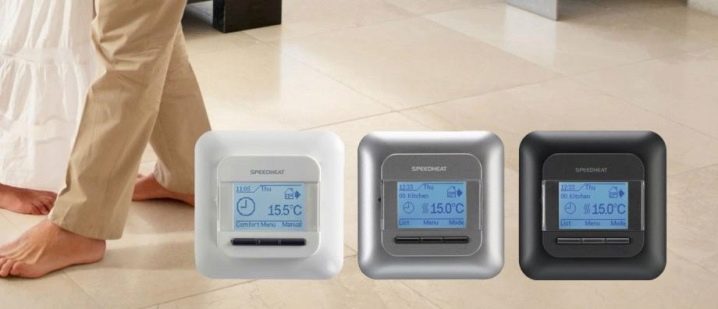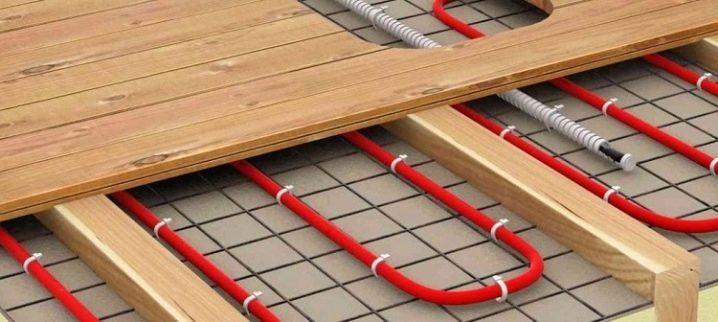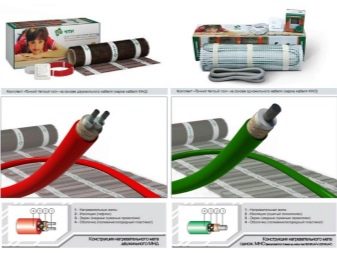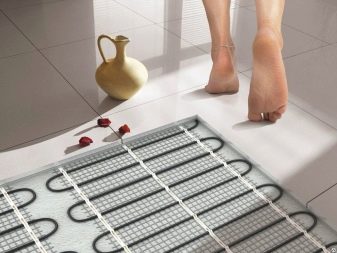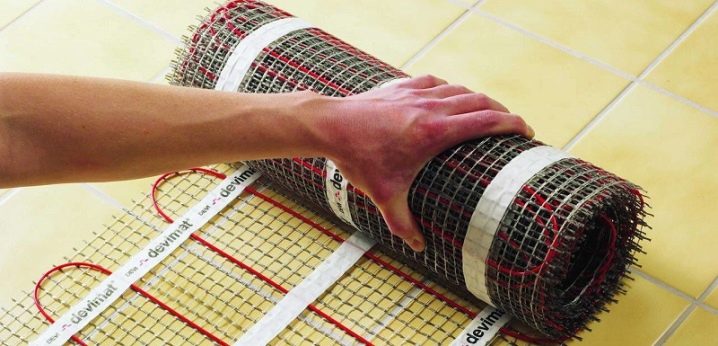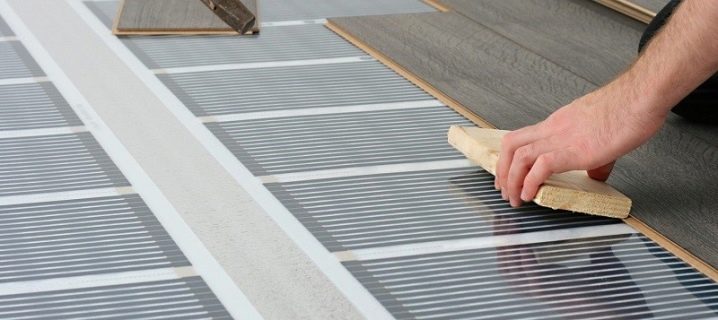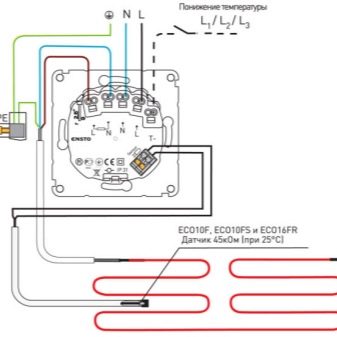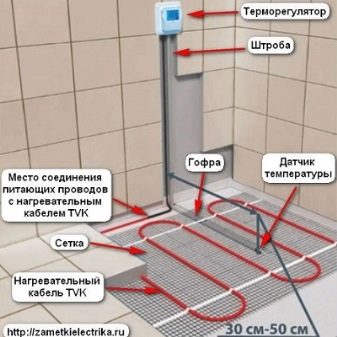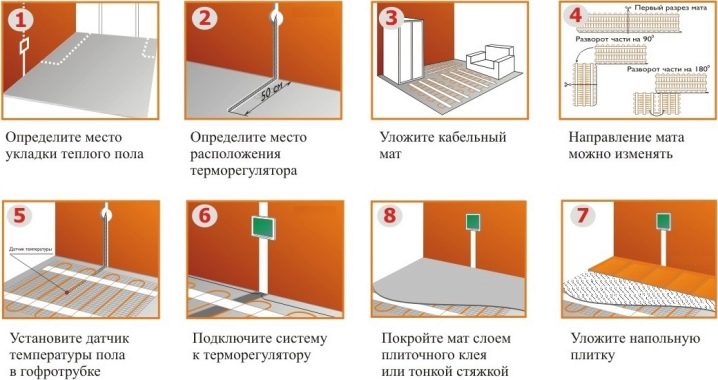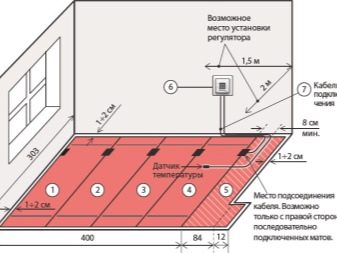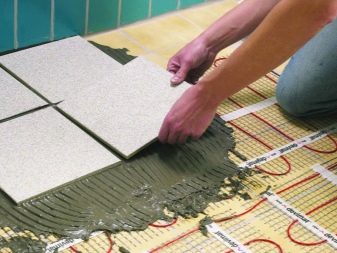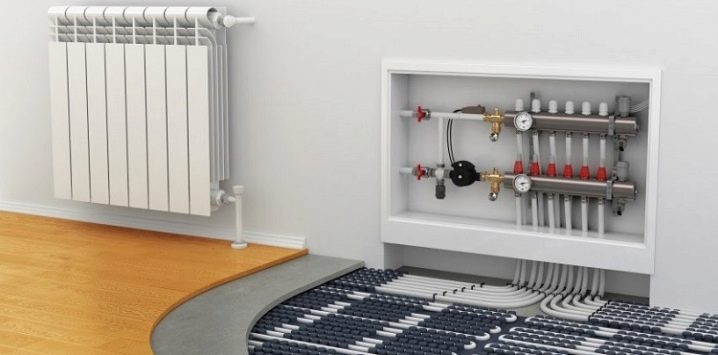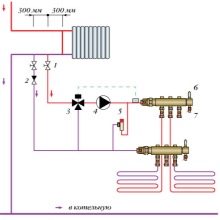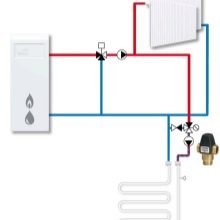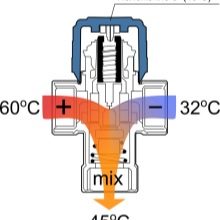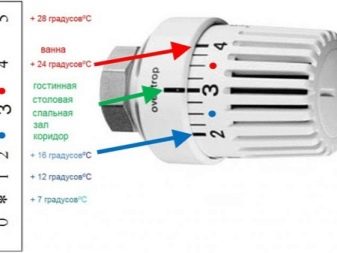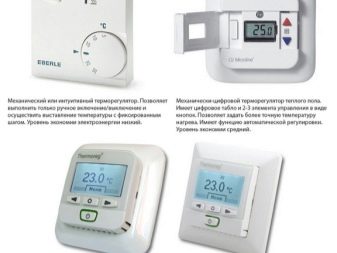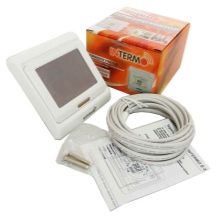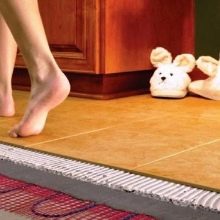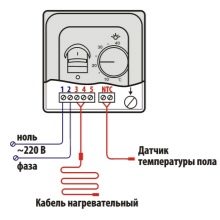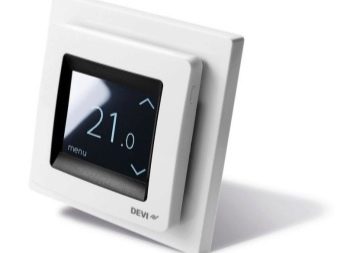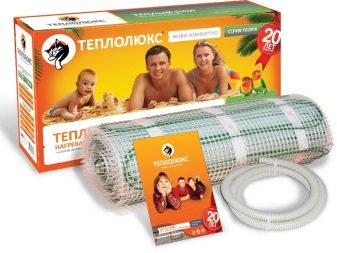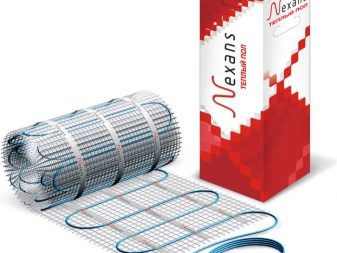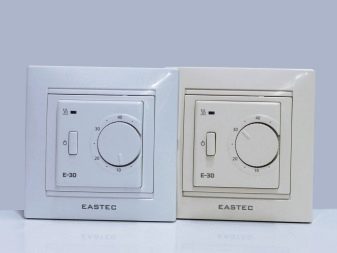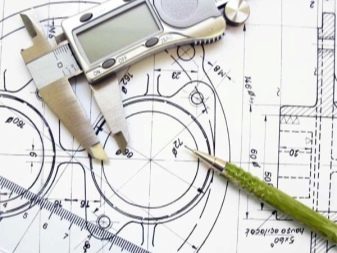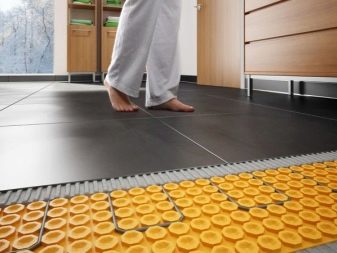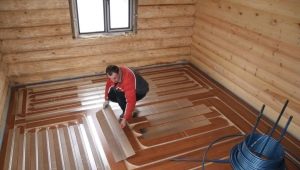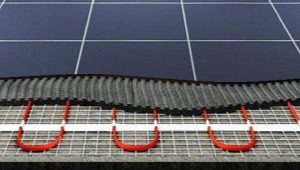Subtleties of connection of a heat-insulated floor to a temperature regulator
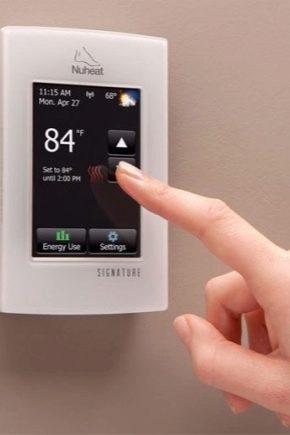
Anyone who starts repairing an apartment wants to make the perfect floor covering, and new technologies contribute in many ways to this. All materials are now available and varied. These are numerous types of ceramic tile, laminate, parquet, or self-leveling floor with a 3D effect.
But besides decorative properties, we should not forget about physical ones, for example, it is not pleasant to step on a cold tile after a hot bath. Therefore, the quality of the flooring is not only in its beauty, but also in a comfortable temperature.
Types and principle of operation
There are two main types of floor heating:
- water;
- electric.
Water warm floor not common among apartment owners of ordinary multi-storey buildings, because such re-equipment of water supply systems in many areas of our country is prohibited by law. Most often installation of a water floor is recommended to be carried out in private houseswhere it is, undoubtedly, will be the most profitable and safe for consumers. Pipes for such gaskets are used, as a rule, metal-plastic or polyethylene.
Electric floor heating is convenient for users by using it with a temperature controller, you can save electricity and make its temperature as comfortable as possible for yourself.
Now often use a dual-zone regulator, which can control the temperature on different warm floors, located in adjacent rooms.
Electric flooring is represented by several varieties:
Cable floor heating
The most economical among electric warm floors. Sold in hardware stores in the form of hanks, stacked snake on a special reinforcing mesh. Subsequently, poured concrete screed. The cable is energized and it emits heat.
Heating resistive cable is of two types:
- single core;
- two-core
The most frequently used is the last two-core.. The reason for this is electromagnetic radiation, it comes from an electrical single-core cable more than from a two-core one. This is due to the fact that the two conductive wires emit two vortex fields, which are at least partially compensated by each other. And since the influence of electromagnetic fields on the human body adversely affects its functioning, it turns out that two-core cable is safer for our health. Using single-core mats is advisable outside the dwelling.
Heating mats
This is a nylon mesh 50 cm wide with a thin heating cable already attached to it with a small pitch (5-7 mm). This method of laying a warm floor was created specifically for rooms where it is not possible to pour a thick layer of concrete screed.
The thickness of the heating core is only 3 mm, which allows laying the floor both by the dry method (directly under the laminate) and wet (for example, in the adhesive layer of the tile). The price of heating mats is higher than on a simple cable floor heating, but they have more advantages: the installation is simple and the mat heats up faster, because the cable is closer to the surface.
Film infrared floor
This is a thin flexible thermofilm, which consists of heating elements (carbon or bimetallic) at the edges of which copper buses are located, and electrical current flows through them. Differs completely dry installation and keeps within under a laminate, a carpet, a parquet, a tile. The heat generated by the infrared floor is evenly distributed, this is different from simple electric floor heating based on the heating cable.
Wiring diagram
Installation and adjustment of an electric heat-insulated floor is a rather simple task. The main thing is to properly arrange the heating elements, connect the system to the thermostat and to the power supply.. Following the recommendations, it is possible with your own hands to correctly make the installation of underfloor heating, without the help of experts.
Regardless of the type of heat-insulated flooring, it is necessary to prepare a thermostat. It is necessary to connect it to the network, think over whether it will be powered from an electrical panel or from an existing outlet. As a rule, the thermostats already show a wiring diagram that facilitates the installation procedure. You also need to drain the ditch in the wall.There you will need to hold two corrugations in the future: in one of them there will be a temperature sensor, and in the other - the power wires of the heating cable. Only after these events can begin the immediate laying of the floor heating.
When connecting the cable floor you need to bring the two ends of the power cable to the thermostat (the connecting sleeve is subsequently filled with a concrete tie).
The easiest and most effective way of laying the cable is a snake, but you can use any other method, avoiding the intersection of cables.
Next you need to install a temperature sensor, it should be placed in a special plastic tube. It will be possible to check the cable warm floor only if the concrete screed has completely dried out.. It is necessary to connect the wires that feed the entire system, the power wires for the heating cable, as well as the wire of the thermal sensor.
The principle of laying the heat mat is similar, you only need to correctly calculate the power per square meter. After laying the mat, it is poured with a thin layer of concrete screed or tile glue and a decorative coating is laid on top. Heat insulation cannot be used, as it will lead to overheating. Coupling is also located inside the screed.
The pattern of laying the infrared film floor differs from the previous ones only by using a special substrate based on foil film. It allows you to reflect the infrared rays in the right direction.
Installation and Setup
In terms of energy resources, installation of a water floor is the most efficient. All pipes of closed systems are controlled by the so-called system of dies (collector) of a heated floor. It is a distribution node in which all pipes of closed heating systems converge.
Comb performs several functions at once:
- Reduces the temperature of the water supplied. The temperature of the heated floor should not exceed 45 degrees.
- Provides the necessary heat in the room, in each circuit controls the flow. For this purpose, flow meters are provided in the collector, they are responsible for water flow.
Installation of a cabinet with a collector takes place relative to the height of the finished planned floor heating.A collector without a cabinet is recommended to be placed at a height not lower than 1 m from the floor level.
Also, a three-way valve is often required in the system to regulate the flow of water. It is precisely its presence in the system that makes it possible to supply water of a stable temperature to the floor installation. On the valve is a thermostatic bush that allows you to adjust the heating at the outlet. Water mixing occurs between the hot water that comes from the boiler and the liquid that comes back from the system, which gives maximum savings.
Thus, the circulation in the system is as follows:
- Hot water from the boiler enters the collector.
- Then it enters the three-way valve; if the water temperature is higher than the desired one, then the valve opens for the entry of cooled water.
- Inside, mixing takes place until the temperature reaches the desired level.
- The valve closes.
As for electric underfloor heating, in this case, you will have to be puzzled by the choice of thermostat and properly configure it, they are:
- with manual or electronic control;
- with the possibility of programming and without it.
The simplest thermostats are mechanical, controlled by a rotary wheel. Have a significant drawback - increased energy consumption, because in this case it is easy to forget and leave the floor heating turned on.
Electronic thermostats - controlled by pressing buttons, the desired temperature and current temperature is displayed on the LCD screen.
Electronic programmable thermostats have the same appearance as simple electronic ones, but they are supplemented with the function of switching the floor on and off at a certain time and even depending on the day of the week (weekday / weekend). The use of such devices is not only convenient, but also helps to save a considerable amount of electricity, if properly programmed.
The only problem for some users may be the complexity of programming such a thermostat. For this, manufacturers include in the kit sufficiently detailed instructions for use, adjustment and adjustment.
The connection of the electronic thermostat is made according to the scheme specified by the manufacturer on the case. There are indications near the terminals intended for one wire or another: two terminals for the floor temperature sensor, three for the power cable (phase,zero and ground) and two for the cable heating the warmer floor (for two-core used 2 wires, for single-core, respectively, one).
When working with the installation of the thermostat do not forget about the observance of elementary safety rules:
- It should de-energize the room.
- Temperature mode of operation of the thermostat is from -5 to +40 degrees.
- Cleaning must be carried out without the use of corrosive chemicals.
- To check the operation of the thermostat is only after the completion of the work, do not start up if the device is disassembled.
Manufacturers Rating
To date, the choice of floor heating systems in stores is quite extensive. In this regard, it is difficult to choose from such a variety of really high-quality product that meets all the requirements.
Therefore, it is necessary to consider the main producers and compare the features of their products:
- "Devi" - manufacturer from Denmark, representing the cable underfloor heating. This brand has an indisputable advantage: Devi service centers are found in almost all big cities of our country, so if you have problems, you can always call a repair specialist who will help solve your problem.Warranty on warm floors of this manufacturer is 20 years, and the cost of their systems are often lower than those of competitors. Devi also produces high quality thermostats, so many give the brand a well-deserved first place.
- "Heatlux" - Russian manufacturer, which became the leader in the domestic market of warm floors in 2010. The manufacturer gives a warranty of 25 years, the price of this product is very pleasant, and the range is quite wide. "Heatlux" produces ultra-thin warm floors, and mobile, and many others, designed to create comfortable conditions.
- "Energy" - a British manufacturer, originally proven to be in his homeland, and later in other countries of the world. Its advantage over other manufacturers is environmental friendliness of materials. Also thermomats "Energy" are considered one of the most economical in terms of electricity consumption by cable, and the cost of the equipment itself. Manufacturer's warranty is 20 years.
- "Nexans" - The Norwegian company, famous all over the world, is famous for its innovative developments. One of them is a thermomat connection without couplings, which allows you to adjust the temperature in different rooms without any special problems.
- Legrand - a world-class specialist, engaged in the production of various electrical and information systems, including thermostats for underfloor heating. Its range includes all types: from simple mechanical to complex programmable regulators. The Celiane series is represented by high-tech programmable systems that will satisfy the most picky customer.
Tips masters
There are nuances that must be considered when installing underfloor heating and connecting them to a thermostat.
- You should carefully measure the area of the room and, accordingly, the length of the cable.
- Initially, it is better to create a plan for installing a floor heating system on paper; you may need it, for example, when rearranging it in a room or doing any repair work.
- It is worth checking the resistance of the system before the cable is poured into the screed, the spread of up to 10% is within the normal range.
- It is better to carry out a performance check only after the complete drying of the screed.
How to connect the thermostat from the warm floor, see the following video.
